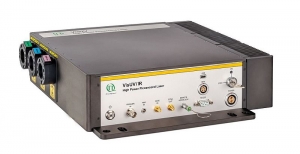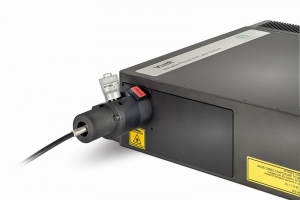High-power and UV Lasers
VisUV
Picosecond Lasers in UV, Green, Yellow, and Orange
Broad pulse (~ 0. 5 ns)
- NEW: High coherent VisUV HC (with coherent length > 85% of temporal pulse length), at 532 nm
- Pulse width ~ 0.5 ns (FWHM)
Narrow pulse (< 85 ps )
- Available wavelengths 266, 280, 295, 355, 488, 515, 532, 560, 590 nm
- Pulse width < 85 ps (FWHM)
Specification applies to narrow and broad pulse:
- Digitial interface, can be controlled via USB, Sepia PDL 828 (with dedicated module SEM 828) and RS232
- Average output power from sub mW to 750 mW (depending on wavelength)
- Repetition rate from single shot up to 80 MHz, external or internal triggering
- Collimated output, optional fiber coupling
The VisUV laser is a versatile and flexible platform based on a Master Oscillator Fiber Amplifier (MOFA) concept with frequency conversion. The master oscillator generates infrared picosecond pulses at 1064 nm with variable repetition rates up to 80 MHz using the proven gain-switching techniques from PicoQuant. The output of this seed laser is directly connected to a multi-stage fiber amplifier, which boosts the output from the seed laser by several dB while maintaining the other characteristics of the seed laser beam like the emission wavelength, polarization and the pulse width.
Compact stand alone device
The VisUV is a stand alone device featuring a special design optimized for maximum heat dissipation. While the classic VisUV laser modules were manually controlled through a series of switches and dials on the device’s front panel, this new generation of modules can now be easily controlled via a variety of interfaces. The VisUV can be connected to a PC via USB interface or (optionally) to a Sepia PDL 828 laser driver through a PicoQuant proprietary interface. In both cases, the VisUV can be fully controlled via an intuitive graphical user interface (GUI) running under Windows. Additionally, the VisUV features an RS232 interface for serial connection. The VisUV laser module includes all driving functions required for laser operation, such as choice of repetition rate, intensity and trigger source.
Flexible wavelength configuration
The high pulse energies of the amplified 1064 nm infrared laser permit efficient wavelength conversions. In that way it is possible to generate picosecond pulses at 266, 280, 295, 355, 532 nm with average optical power values ranging from sub mW up to 750 mW depending on the wavelength and power version. Any wavelength is available individually or in combination with one or two other wavelengths. Each wavelength is emitted from a separate beam output equipped with an individual shutter.
Flexible repetition rate
The VisUV can be operated at 12 different internally selectable repetition rates between 31.25 kHz and 80 MHz and can also be triggered externally by TTL or NIM signals at any repetition rate between single shot and 80 MHz.
Excellent beam quality
The VisUV features nearly perfectly circular and gaussian shaped beam profiles (TEM00) and M² values down to 1.02 at some wavelengths.
| Optical output | |
|---|---|
| Available wavelengths | 266 to 590 nm |
| Spectral width | < 1 nm |
| Polarization Extinction Ratio (PER) | > 1 : 300 (> 25 dB) |
| Power Stability (12 hours) (ΔT (ambient) < 0.5 K) | < 3 % rms |
| Other optical specs (power, pulse, beam shape) | See tab Wavelengths |
| Repetition rates | |
| Internal | |
| Range | user selectable: 80, 40, 20, 10, 5 or 2.5 MHz (80 MHz base frequency) 1000, 500, 250, 125, 62.5 or 31.25 kHz (1 MHz base frequency) |
| External via NIM input | |
| Range | <1 Hz to 80 MHz |
| Trigger level | fixed trigger level at - 400 mV |
| Connector | NIM-CAMAC |
| External via TTL input | |
| Range | <1 Hz to 80 MHz |
| Amplitude | - 5 to + 5 V (maximum limits) |
| Trigger level | adjustable between - 1 V and + 1 V |
| Connector | BNC |
| Synchronization output | |
| Amplitude | < -800 mV into 50 Ohm (NIM) |
| Connector | SMA |
| Timing | synchronous to the pulse repetition rate |
| Delays | |
| Trigger in (NIM) to sync out | Typ. 9 ± 1 ns |
| Trigger in (NIM) to optical out | Typ. 80 ns |
| Sync out to optical out | Typ. 70 ns |
| For multiple optical outputs: Max time delay between different output pulses |
< 1 ns |
| USB interface | |
| Connector type | USB Type-C 3.0 |
| USB version | 2.0 |
| Compatibility | PQ Laser Driver Software under WindowsTM 10 |
| RS232 interface | |
| Connector type | Sub-D9 female |
| Baud rate | 115200 |
| Data | 8 bit |
| Parity | none |
| Stop | 1 bit |
| Sepia interface | |
| Connector | LEMO, PicoQuant proprietary interface to connect to dedicated Sepia Extention Module SEM 828 |
| Compatibility | PQ Laser Driver Software under WindowsTM 10 |
| Gating | |
| Connector | SMA female |
| Remote interlock | |
| Connector | 4 pin LEMO EGG.00.304.CLL female |
| Dimensions | |
| Size | 352 × 336 × 82.5 mm (l × w × h) |
| Weight | 6.5 to 9.0 kg1 |
| Operation | |
| Temperature range | 10-30 °C |
| Power supply | 100 to 250 VAC, 50/60 Hz, max 130 Watts |
1 Single beam versions typ. 6.5 kg, multi-beam versions up to 9 kg
All Information given here is reliable to our best knowledge. However, no responsibility is assumed for possible inaccuracies or omissions. Specifications and external appearances are subject to change without notice.
The following table summarizes the optical specifications for the respective models
| Type | Wavelength [nm] |
Pulse (FWHM) [ps] |
Max. avg. power [mW] |
Divergence [mrad] |
Beam diameter [mm] |
Beam quality |
| Multicolor modules | ||||||
| VisUV-266-355-5321 | 266 (± 1)2 | < 85 | > 2.0 | < 2 | 1.0 ± 0.2 | M² < 1.1 (vertical) M² < 1.5 (horizontal) |
| 355 (± 1) | < 85 | > 5.0 | < 0.5 | 1.5 ± 0.2 | M² < 1.2 (typ. ~ 1.1), TEM00 | |
| 532 (± 2) | < 85 | > 250 | < 0.5 | 2.1 ± 0.2 | M² < 1.1 (typ. ~ 1.02), TEM00 | |
| VisUV-280-5603 | 280 (± 1)2 | < 85 | > 1.0 | < 2 | 1.0 ± 0.2 | M² < 1.1 (vertical) M² < 1.5 (horizontal) |
| 561 (± 1) | < 85 | > 150 | < 0.5 | 2.1 ± 0.2 | M² < 1.1 (typ. ~ 1.02), TEM00 | |
| VisUV-295-5903 | 295 (± 1)2 | < 85 | > 0.5 | < 2 | 1.0 ± 0.2 | M² < 1.1 (vertical) M² < 1.5 (horizontal) |
| 589 (± 1) | < 85 | > 60 | < 0.5 | 2.1 ± 0.2 | M² < 1.1 (typ. ~ 1.02), TEM00 | |
| Single color modules | ||||||
| VisUV-2661 | 266 (± 1)2 | < 85 | > 2.0 | < 2 | 1.0 ± 0.2 | M² < 1.1 (vertical) M² < 1.5 (horizontal) |
| VisUV-266-MIC3 | 266 (± 1) | < 85 | > 1.0 | < 0.5 | 1.5 ± 0.2 | M² < 1.2 (typ. ~ 1.1), TEM00 |
| VisUV-3553 | 355 (± 1) | < 85 | > 10 | < 0.5 | 1.5 ± 0.2 | M² < 1.2 (typ. ~ 1.1), TEM00 |
| VisUV-4883 | 488 (± 1) | < 60 | > 50 | < 1 | 1.0 ± 0.2 | M² < 1.1 (typ. ~ 1.02), TEM00 |
| VisUV-5321 | 532 (± 2) | < 85 | > 300 | < 0.5 | 2.1 ± 0.2 | M² < 1.1 (typ. ~ 1.02), TEM00 |
| VisUV-532-HC1,4 | 532 (± 2) | Typ. 0.4 ns | > 750 | < 0.5 | 2.1 ± 0.2 | M² < 1.1 (typ. ~ 1.02), TEM00 |
| VisUV-5603 | 561 (± 1) | < 85 | > 50 | < 1 | 2.0 ± 0.3 | M² < 1.1 (typ. ~ 1.02), TEM00 |
| VisUV-532-HP1 | 532 (± 2) | < 1000 | > 750 | < 0.5 | 2.1 ± 0.2 | M² < 1.1 (typ. ~ 1.02), TEM00 |
1 this module is a class 4 laser product
2 Limited collimation range. low power version with improved beam quality is available on demand
3 this module is a class 3b laser product
All measurements shown may be subject to a 10% callibration error.
Each VisUV module undergoes an extensive burn-in test to ensure long-term stability and is shipped with a comprehensive set of test data. This test data is kept in our database, which already holds records of more than 15 years.
All Information given here is reliable to our best knowledge. However, no responsibility is assumed for possible inaccuracies or omissions. Specifications and external appearances are subject to change without notice.
The VisUV can be used for various applications, such as:
- Time-resolved Fluorescence
- Stimulated Emission Depletion Microscopy (STED)
- Fluorescence Lifetime Imaging (FLIM)
- Phosphorescence Lifetime Imaging (PLIM)
- Fluorescence Correlation Spectroscopy (FCS)
- Fluorescence Lifetime Correlation Spectroscopy (FLCS)
- Foerster Resonance Energy Transfer (FRET)
- Dual Focus Fluorescence Correlation Spectroscopy (2fFCS)
- Pulsed Interleaved Excitation (PIE)
- Fluorescence Anisotropy (Polarization)
- Singlet Oxygen
- Laser Cutting/Ablation
- Time-Resolved Photoluminescence (TRPL)
- TRPL Imaging
- Lanthanide Upconversion
- LIDAR/Ranging/SLR
- Antibunching
- 3D polymerization
- Single Molecule Spectroscopy
The following documents are available for download:
Latest 10 publications referencing VisUV
The following list is an extract of 10 recent publications from our bibliography that either bear reference or are releated to this product in some way. Do you miss your publication? If yes, we will be happy to include it in our bibliography. Please send an e-mail to info@picoquant.com containing the appropriate citation. Thank you very much in advance for your kind co-operation.




 Contact us
Contact us
